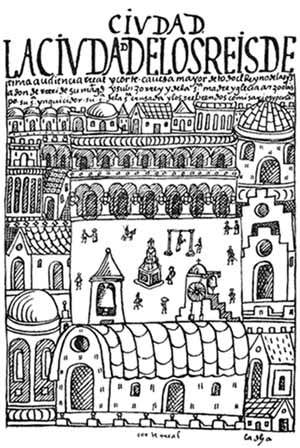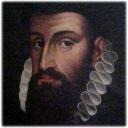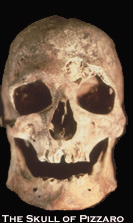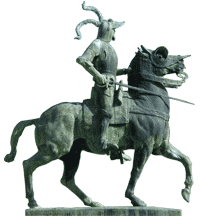The Last Days of the Incas’ Peru Tour #4 (Lima)

Lima (1 Day) The Plaza de Armas, Francisco Pizarro’s Statue, Pizarro’s Remains, Cerro San Cristóbal
Visiting San Cristobal Hill (Cerro San Cristóbal), where the Inca General Quiso surveyed the battlefield before his defeat.
It was here, on top of Cerro San Cristóbal, which juts above downtown Lima, that the Inca Emperor Manco Inca’s finest general, Quiso, surveyed the fledgling town of Lima (shown at left in a drawing by the 16th century Peruvian artist, Felipe Huamán Poma de Ayala) in 1536, prior to his all-out assault on it.
Trapped within it was Francisco Pizarro and about 100 of his men, along with some thousands of coastal and other natives who had sided with the Spaniards. General Quiso was fresh from recent victories—he had just wiped out four columns of Spaniards in the Andes, almost to the man. The Inca Emperor Manco Inca had just rewarded him with his own sister as the general’s new wife, and with a high status litter upon which the general was now carried…
(more…)
The Last Days of the Incas’ Peru Tour #3 (Lima)


Lima (1 Day) The Plaza de Armas, Francisco Pizarro’s Statue, Pizarro’s Remains, Cerro San Cristóbal
The Strange Missing Skeleton of Francisco Pizarro
Although many tourists stay in Miraflores, one of Lima’s upscale and more modern suburbs on the coast, the most interesting area of Lima from a historical and visual point of view is its original center, built around the Plaza de Armas. Lima’s colonial downtown area, in fact, was declared a World Heritage Site by UNESCO in 1988. This is the original square that Francisco Pizarro outlined in the barren sand in 1535, just a block south of the Rimac River, when he was 57 years old, and it was on this square (on its western side, across from the Cathedral) that Pizarro had his house built—and where he was later assassinated. The plaza is now fronted by the Palacio del Gobierno, on the same site where Pizarro built the first government palace; this is where the current Peruvian President lives.
On the eastern side of the square looms the cathedral, destroyed in a massive earthquake in 1746 and rebuilt on the same site during the following decade. In one of the apses of the cathedral lie Pizarro’s remains. In the distance (to the northeast) on the other side of the Rimac River, one can still see (and visit) the looming San Cristobal hill (Cerro San Cristóbal), where the Inca general Quispe and his army once camped during their assault on the fledgling capital, defended by Pizarro and roughly 100 of his desperate men…
(more…)
The Last Days of the Incas’ Peru Tour #2 (Lima)

Lima (1 day) The Plaza de Armas, Francisco Pizarro’s Statue, Pizarro’s Remains, Cerro San Cristóbal
Most visitors spend little if any time in Lima, Peru’s capital of 10 million; it’s crowded, noisy, not visually dramatic, and is for a good part of the year (June through December) covered in a thin haze of garua, or fog. However, even a day spent there can be rewarding in terms of visiting some of the sites described in The Last Days of the Incas, and when the sun is out and you are eating a fine plate of ceviche (raw fish “cooked” in lemon juice) in a seaside restaurant, Lima can be a very pleasant place indeed.
Whereas the Lima coastal area was settled for thousands of years before the Incas conquered this area, the actual city of Lima was actually founded by Francisco Pizarro in 1535, shortly before the Incas rose up massively against his rule. It was here, in 1536, that the Inca Emperor Manco Inca’s finest general, Quiso, led an army against Pizarro and 100 of his Spaniards that nearly wiped out the last Spaniards in Peru. It was here, in 1541, that Pizarro was assassinated and it is still here, in the Cathedral on the Plaza de Armas, that Pizarro’s bones are kept in a crypt, more than four centuries after his assassination. They are still scarred by his assassins’ swords and daggers…
(more…)




